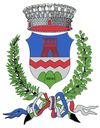Omegna
| Omegna | ||
|---|---|---|
| Comune | ||
| Comune di Omegna | ||
 |
||
|
||
| Location of Omegna in Italy | ||
| Coordinates: 45°52′39″N 8°24′32″E / 45.87750°N 8.40889°E | ||
| Country | Italy | |
| Region | Piedmont | |
| Province / Metropolitan city | Verbano-Cusio-Ossola (VB) | |
| Frazioni | Bagnella, Borca, Crusinallo, Cireggio, Santa Rita, Agrano, Gattugno, Sant'Anna | |
| Government | ||
| • Mayor | Maria Adelaide Mellano (PD) | |
| Area | ||
| • Total | 30.78 km2 (11.88 sq mi) | |
| Elevation | 295 m (968 ft) | |
| Population (31 December 2012) | ||
| • Total | 15,591 | |
| • Density | 510/km2 (1,300/sq mi) | |
| Demonym(s) | Omegnesi | |
| Time zone | CET (UTC+1) | |
| • Summer (DST) | CEST (UTC+2) | |
| Postal code | 28887 | |
| Dialing code | 0323 | |
| Patron saint | Saint Ambrose | |
| Saint day | 7 December | |
| Website | Official website | |
Omegna [oˈmɛ:ɲɲa] is a comune (municipality) in the Province of Verbano-Cusio-Ossola in the Italian region Piedmont, located about 100 kilometres (62 mi) northeast of Turin and about 13 kilometres (8 mi) southwest of Verbania at the northernmost point of Lago d’Orta and traversed by the Nigoglia, the lake's sole outflow.
The presence of ancient settlement in the area has been proved by excavations held in the frazione of Cireggio, archaeological findings dating from the late Bronze and Iron Ages. Omegna is mentioned in 1221 AD, when the population gave itself to the commune of Novara.
In the 19th and early 20th century it became an industrial center (it was for many years the main centre for production of pots and small home appliances in Italy) and the population was increased by immigrants. In 1913 Omegna was connected with Pallanza by an electrical tramway line. It was declared a city in 1939. During World War II it was a center of partisan resistance against the German-Fascist occupation.
...
Wikipedia


